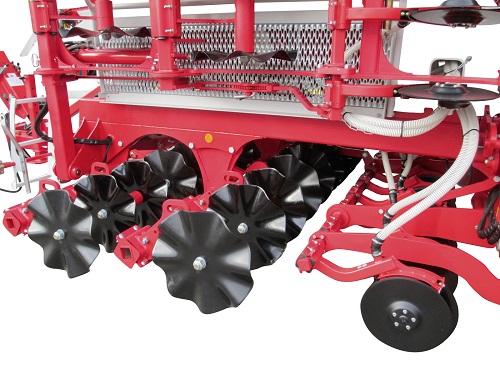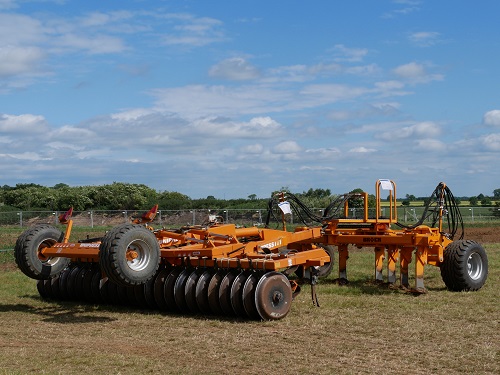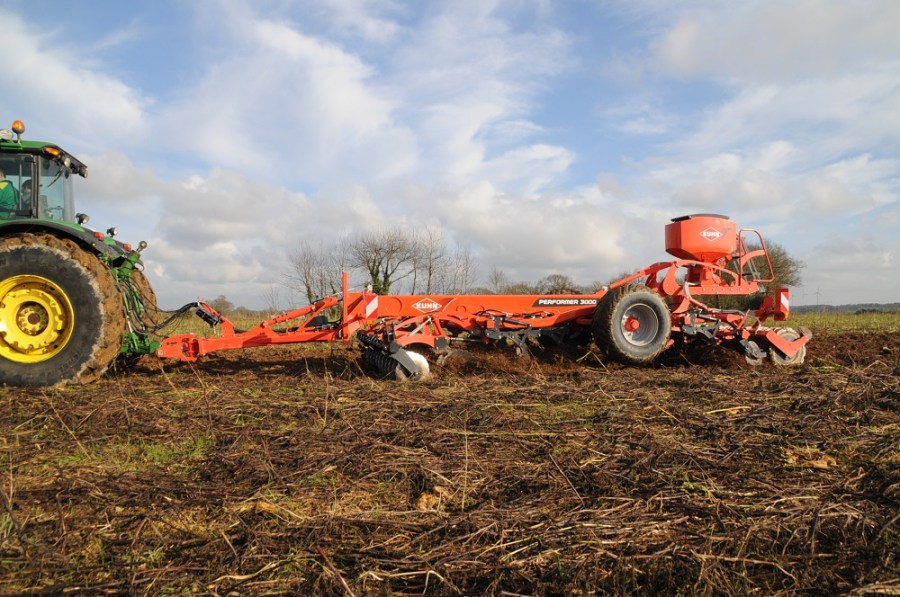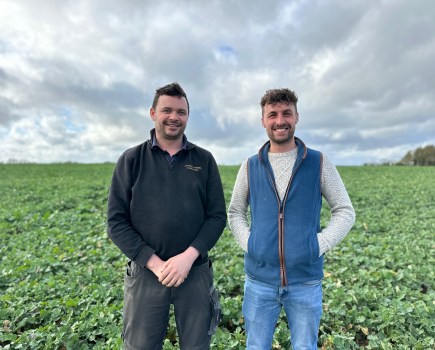No single solution fits the bill for the cultivation challenges faced by British farmers, and choice ranges from compete inversion to no-till drilling. CPM takes a look at some of the kit currently on offer.
Ploughing continues to be an essential part of many farmers’ cultivation rotations.
By Jane Brooks
Back in March, Kuhn added hydraulically folding 6m and 7m versions to the 4m and 5m models already in its Performer range of non-powered, one-pass deep tine-disc cultivators.
A 3m version has now been added to the range to meet the requirements of lower horsepower tractors.
The Performer can be equipped with two rows of 510mm independent and hydraulically adjustable discs (22 discs in total, spaced at 289mm centres), and four rows of non-stop hydraulic (900kg) tines capable of working to a maximum depth of 350mm (10 tines in total). Eight hydraulically adjustable levelling discs can also be used.
A choice of shares for mixing or loosening soil, including standard 80mm shares, 50mm subsoiling shares or wing shares, can be specified, and, in common with its larger siblings, the Performer 3000 uses the same HD Liner 700 notched roller with up to 225kg/m of hydraulically adjustable pressure to provide soil consolidation.
Kuhn says the Performer offers an effective single-pass solution and different modes suiting various soil conditions and cultivation requirements. Discs and a roller can be used for surface cultivation, tines and a roller for sub-soiling, discs and tines for more aggressive work, or a roller-free configuration for non-consolidation work.
There are low service requirements thanks to the use of maintenance-free hubs and bearings and drop-forged tines. It uses Kuhn’s signature central beam design for added robustness and has an under-frame clearance of 850mm.
The Performer 3000 is fitted with hydraulically or pneumatically operated transportation wheels and has an in-transit width of 2.95 metres. It has a maximum tractor power rating of 250kW (350hp) and weighs 5000kg when fitted with the HD-Liner 700 roller.
Opico has launched He-Va’s new 3m split-folding V-Profile Front Press, an addition to its range of front presses. The machine hydraulically splits into two vertical sections for a 2.13m transport width.
“This new 3m folding front press will allow customers working with narrow lanes to have access to a best-selling product so that, whatever their soil type, road width and field entry, they can use this simple one-pass cultivator ahead of the drill,” says Opico’s James Woolway.
In common with the rigid 3m and larger folding models, the press is available with either a 600mm or 700mm castellated pressed steel V-profile ring to offer optimum consolidation, whilst having a sharp rib to maximise clod crushing.
Available with spacing of 125mm (600mm rings) and 156mm (700mm rings), with a scraper between each ring, the press offers full width consolidation on light or heavy land.
The rings can turn individually but are linked by a series of lugs that ensure they all drive together, meaning the machine won’t be phased even by the wettest, sticky conditions.
There’s an optional shattaboard, hydraulically adjustable from the tractor seat, it increases the cultivation action allowing the machine to level, crush and consolidate in one pass ahead of the drill.
The Front Press has a long headstock effectively becoming an extension of the front of the tractor when attached. The headstocks are designed to take the forces produced even when using a shattaboard.
Low disturbance
Austrian machinery manufacturer Pottinger unveiled a novel low disturbance disc design this spring – its 510mm wave disc which is available on Terrasem R3 and R4 and Terrasem C4, C6, C8 and C9 seed drills and all models with direct fertilisation.

Pottinger’s wave disc has a wavy profile, which is angled in the direction of travel.
True to its name the wave disc has a wavy profile. With a diameter of 510 mm and available with row spacings of 12.5cm or 16.7cm, working depth is infinitely adjusted by a hydraulic system. Each disc is positioned in front of the seeding coulters only cultivating ground near the seed.
This, Pottinger says, allows minimum soil disturbance when tilling a new crop, moving only 36% of ground on 12.5cm row spacings and 27% in 16.7cm rows.
The minimised soil movement leaves no cavities or clods in the cultivated area limiting germination conditions for weeds such as black grass, wild oats and brome.
Pottinger claims as well as reducing fuel use due to more efficient operation, the new discs will work in a wide range of soil conditions.
As an addition to its C-Mix shares, Amazone has introduced the C-Mix-Clip quick-change system for the Cenius mulch cultivator series.
In common with C-Mix shares the C-Mix-Clip share system consists of a guide plate and tip. On the C-Mix-Clip system, the guide plate is fixed to the tine and the tip is then fixed on the quick-change system.
After the initial, simple assembly of the C-Mix-Clip bracket on to the tine, different share tips can be attached with the aid of an easily detachable locking pin.
The securing pin is guided at the reverse side of the tine through a hollow bolt and thus holds the relevant share tip safely on the C-Mix-Clip bracket.
Amazone offers a 80mm-wide tine, which is particularly suited to intensive loosening at working depths of 12-30cm. A 100mm wide share tip is available, suitable for 10-20cm working depths as well as deeper stubble tillage and primary soil tillage.
Also available is a 320mm-wide goosefoot share tip, which is used for the shallow and overall stubble tillage of 3-10cm. A special tool is available to firmly push the share onto the C-Mix-Clip bracket.
Using an innovative lateral folding system, the Brock Sub-V subsoiler can be used with or without the rear packer/roller.

The Brock Sub-V subsoiler’s innovative design allows it to operate with or without a packer, of which there are many options including the Brock soil packer.
The versatile subsoiler is capable of soil preparation down to depth of more than 0.75m. The tough design suits the largest tractors and allows a working width of up to 8m; however, it folds to a transport width of within 3m.
Derry Morton of Brocks Sales Manager explains: “The Sub-V doesn’t rely on a packer for depth control but the rear drawbar allows it to tow a separate press. We featured it with a Simba UniPress at last month’s Cereals Event.
“It can be run with any other following equipment but the main thing about not relying on a packer is that you can keep on working in less favourable conditions.”
Breaking new ground
Maschio’s range of mounted reversible ploughs for tractors from 120hp to 300hp are now available in the UK.
“We’re starting off with mounted units to get the ball rolling,” says Maschio sales manager Robin Immink, “but semi-mounted models will follow in due course.”
Importer Opico feels that a plough is the logical thing to complete the Maschio tillage range.
“We felt the timing was right to bring the Maschio plough into the UK,” says James Woolway. “Despite changes in tillage practices, ploughing continues to be an essential part of many farmers’ cultivation rotations and we wanted to be able to offer our customers the full range.”
There are two model ranges – the 3f to 5f mid-range Unico M suitable for tractors up to 200hp and the 4f to 6f heavy duty Unico L which is built to cope with up to 300hp.
Key features include fast front furrow width adjustment; a double-arm parallelogram linkage ensures the line-of-pull remains straight and true, as front-furrow settings are altered hydraulically. Quick-fit, rapid-adjust skimmers with a simple pin and hole set-up, helps achieve optimal trash burial.
Mechanical or hydraulic vary-width, bolt adjustment provides fine-tuning in 5cm increments – 27-54cm (depending on spec.) while on-the-move hydraulic adjustment runs from 25–55cm. Inter-body clearance is 95cm and under beam clearance 80cm, other options are available.
Turnover memory function closes the bodies up automatically when turning the plough over, ensuring nothing hits the ground, returning to the pre-set position once back in working position. However, it doesn’t do it by closing up the vary width linkage, instead it uses the beam alignment ram, which means pins; bushes and link rods don’t wear with every turnover.
Hydraulic auto-reset – centralised hydro-pneumatic circuit with piston nitrogen accumulator makes for fast leg reset. The first body’s fitted with a larger diameter cylinder for higher trip pressure as the leading point’s going into unbroken ground.
Maschio says switching between sizes and types of mouldboard just involves loosening a few bolts. Slatted and conventional bodies are available many are interchangeable with other ploughs on the market.
A range of wearing metal gives a wide choice of bodies. Maschio’s MP4WD mouldboard works at depths from 15-35cm and can run at up to 50cm wide or be wound right in to 30cm.
There’s a combination depth/transport wheel and optional hydro-pneumatic suspension.
British-built ploughs
Following Dowdeswell Engineering ceasing plough production in Aug 2015, Suffolk based Agrihire now manufactures a range of reversible ploughs. Agrihire were Dowdeswell dealers and parts suppliers for many years and have a guaranteed parts supply from Dowdeswell’s sister company DPS.
Branded as Hubert Ploughs, these successors to the Dowdeswell plough range are available from 5f to 10f to suit horse powers up to 600hp. In furrow and on land options are available, with a choice of bodies including DD, DDS, UCN, SCN, and slatted. They also come with single-bolt skimmer adjustment, heavy-duty depth/transport wheel and rear disc option.
Using a combination of genuine Dowdeswell parts and some modern updates i.e. box section main beams, one piece leg carriers and parts manufactured from weldox plate, they’ve produced a plough where all parts are completely interchangeable with the old Dowdeswell models.
Ben Clowes of Agrihire explains that one of the modern updates to the Dowdeswell design is the use of high tensile Swedish steel box section for the main beams. “Currently our ploughs have manual vari-width adjustment and shear bolt stone protection, which suits our customers, however if the market dictates we’ll look into auto adjustment and stone protection – everything is an ongoing development.”
Contracting prices rises ‘inevitable’
The National Association of Agricultural Contractors (NAAC) warns that rising input costs could lead to rate increases.
Publishing the NAAC 2017 charges, NAAC chief executive Duncan Russell notes that prices haven’t risen significantly since last year. “But the time’s coming that increases are inevitable. We’re seeing rapidly increasing machinery purchasing costs, alongside hikes in spare parts and tyres, which simply can’t continue to be absorbed by the contracting sector.”
An estimated 91% of farmers use a contractor and many sectors are increasingly reliant on their services.
The way contractors work with their customers needs to become a closer partnership, reckons the NAAC. This will allow contractors to make the massive investment in capital costs required to purchase and maintain multi-million pound fleets of machinery.
“I just want to provide a good service, on time to my customers,” says NAAC chairman and contractor Martin Hays. “It’s what most contractors want, whilst earning a living. However, as machinery costs continue to climb, alongside the costs of other inputs, I’m looking hard at my charging schedule and other contractors should be doing the same.
“Machinery costs aren’t static so neither should our charges be. While we may be doing OK this year, when it comes to upgrading or trading machines and tractors in coming months and years we may easily find our costs have fallen behind and we can’t make up the shortfall.
“Farmers will have exactly the same problems and we need to work together so that contractors can make those long term investments in labour and kit to keep the farming industry sustainable for the future.”
Current NAAC Contracting Charges, which are given as a guide are based on data collected across the UK, are available on the NAAC website. www.naac.co.uk
Not just for potatoes
Grimme’s latest addition to their GT Tilla range the GF600 hydraulic three-bed folding Tilla was originally shown as a prototype at Lamma 2016.
Grimme spent two years developing the GF600 alongside UK growers to ensure maximum reliability.
The GF600 features a heavy-duty CAT 3 linkage, sprung loaded hoods and a specified working width of 5.4m (three beds). It’s equipped with a 325hp or an optional heavy-duty 500hp central gearbox, driving the two “Speed Blade” rotors through 250hp rated end gearboxes.
Growers have the choice between BF BedForma or Shapeforma ridging bodies for potato beds. Optional crumbler roller or vegetable hoods are available, showing that the GF600 isn’t just for potatoes. Additional options include hydraulic folding markers, parallelogram linkages and wheel track eradicator tines.




